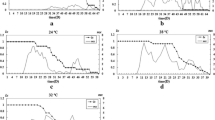Abstract
The author has studied the influence of different temperatures (22°, 24°, 26°, 28°C) on oviposition and longevity ofOpius concolor siculus Mon., studying separately 13 couples at 22°, 15 at 24°, 100 at 26° and 11 at 28°C.
The optimum temperature has been found to be 26°C. Differences have been observed betweenO. concolor Szepl. «African» andO. concolor siculus Mon. «Sicilian».
Résumé
L'auteur a étudié l'influence de différentes températures sur la ponte et sur la longévité de l'Opius concolor siculus en expérimentant 13 couples à 22°, 15 à 24°, 100 à 26° et 11 à 28°C. La température de 26° se montra plus favorable.
On a trouvé des différences entreOpius concolor Szepl. «Africains» et lesOpius concolor siculus Mon. «Siciliens».
Similar content being viewed by others
References
Arkin, H. &Colton, R. R. — 1955. Statistical methods. —Barnes & Nobles, New York, 226 pp.
Genduso, P. — 1967. Attuale tecnica di allevamento dell'Opius concolor Szepl. siculus Mon. —Boll. Ist. Entomol. agric. Palermo, 7, 9–40.
Monastero, S. — 1967. La prima grande applicazione di lotta biologica artificiale contro la mosca delle olive (Dacus oleae Gmel.). —Boll. Ist. Entomol. agric. Palermo, 7, 63–100.
Monastero, S. &Delanque, P. — 1965. Lotta biologica artificiale contro la mosca delle olive (Dacus oleae Gmel.) a mezzo dell'Opius concolor Sz. siculus Mon. nelle isole Eolie (Sicilia). —Boll. Ist. Entomol. agric. Palermo, 6, 61–79.
— 1966. Un grande esperimento di lotta biologica artificiale contro la mosca delle olive (Dacus oleae G.) a mezzo dell'Opius c. Sz. Siculus Mon. in Sicilia. —Boll. Ist. Entomol. agric. Palermo, 7, 145–194.
Monastero, S. &Genduso, P. — 1964. Esperimenti di lotta biologica artificale contro la mosca delle olive eseguiti nel 1964 nell'isola di Salina (Eolie). —Boll. Ist. Entomol. agric. Palermo, 5, 281–289.
Ragusa, S. — 1968. Relation sur le nombre d'œufs qu'une femelle d'Opius concolor siculus Mon. peut pondre. —Boll. Ist. Entomol. agric. Palermo, 7, 1–3.
Stavraki-Pavlopoulou, H. G. — 1966. Contribution à l'étude de la capacité reproductrice et de la fécondité réelle d'Opius concolor Szepl. [Hymenoptera-Braconidae]. —Ann. Epiphyt., 17, 391–435.
Author information
Authors and Affiliations
Additional information
The author espresses his thanks to Prof.E. Swirski, Division of Entomology at the Volcani Center, Bet-Dagan (Israel) for his advice in the preparation, and to Dr Vermes for his suggestions in the elaboration of the results.
Rights and permissions
About this article
Cite this article
Ragusa, S. Influence of temperature on the oviposition rate and longevity ofOpius concolor siculus [Hymenoptera: Braconidae]. Entomophaga 19, 61–66 (1974). https://doi.org/10.1007/BF02371509
Issue Date:
DOI: https://doi.org/10.1007/BF02371509




